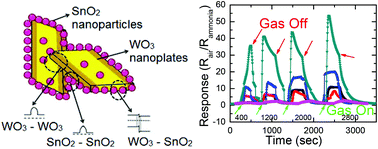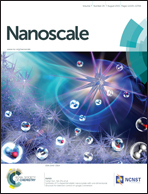Hierarchical nanostructured WO3–SnO2 for selective sensing of volatile organic compounds†
Abstract
It remains a challenge to find a suitable gas sensing material that shows a high response and shows selectivity towards various gases simultaneously. Here, we report a mixed metal oxide WO3–SnO2 nanostructured material synthesized in situ by a simple, single-step, one-pot hydrothermal method at 200 °C in 12 h, and demonstrate its superior sensing behavior towards volatile organic compounds (VOCs) such as ammonia, ethanol and acetone. SnO2 nanoparticles with controlled size and density were uniformly grown on WO3 nanoplates by varying the tin precursor. The density of the SnO2 nanoparticles on the WO3 nanoplates plays a crucial role in the VOC selectivity. The responses of the present mixed metal oxides are found to be much higher than the previously reported results based on single/mixed oxides and noble metal-doped oxides. In addition, the VOC selectivity is found to be highly temperature-dependent, with optimum performance obtained at 200 °C, 300 °C and 350 °C for ammonia, ethanol and acetone, respectively. The present results on the cost-effective noble metal-free WO3–SnO2 sensor could find potential application in human breath analysis by non-invasive detection.


 Please wait while we load your content...
Please wait while we load your content...